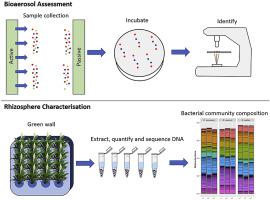当前位置:
X-MOL 学术
›
Build. Environ.
›
论文详情
Our official English website, www.x-mol.net, welcomes your feedback! (Note: you will need to create a separate account there.)
Characterisation of fungal and bacterial dynamics in an active green wall used for indoor air pollutant removal
Building and Environment ( IF 7.4 ) Pub Date : 2020-07-01 , DOI: 10.1016/j.buildenv.2020.106987 R. Fleck , R.L. Gill , T. Pettit , P.J. Irga , N.L.R Williams , J.R Seymour , F.R. Torpy
Building and Environment ( IF 7.4 ) Pub Date : 2020-07-01 , DOI: 10.1016/j.buildenv.2020.106987 R. Fleck , R.L. Gill , T. Pettit , P.J. Irga , N.L.R Williams , J.R Seymour , F.R. Torpy

|
Abstract Indoor air quality (IAQ) is of growing public health concern which has prompted the use of plants to phytoremediate air pollution in interior spaces. Active green walls are emerging as a means of reducing indoor contaminants and have demonstrated efficacy comparable to conventional air filtering technologies. However, the use of active airflow through organic substrates has the potential to emit bioaerosols into the surrounding environment, where the potential risk to human health is largely unknown. In this study, we demonstrate that two indoor green walls (with and without active airflow) contribute significantly to the ambient fungal load, however concentrations remained well below WHO safety guidelines. Bacterial dynamics within the rhizosphere/substrate of the operational botanical biofilters displayed variability across plant species. Phyla-wide distribution generally aligned with previous literature; however, differences from those previously reported were observed at the genus level, possibly due to geographic location, substrate composition, or plant species selection. Targeted assessment of Legionella aerosol contamination, an under-addressed potential pathogen for these active systems, yielded no positive identification during the sampling period. We conclude that active green walls host a unique bacterial profile and do not emit harmful levels of fungal propagules or pose significant risk of aerosolised Legionella species, provided systems are well monitored and maintained.
中文翻译:

用于去除室内空气污染物的活性绿墙中真菌和细菌动力学的表征
摘要 室内空气质量 (IAQ) 日益受到公众健康的关注,这促使使用植物来植物修复室内空间的空气污染。主动绿墙正在成为减少室内污染物的一种手段,并已证明其功效可与传统空气过滤技术相媲美。然而,通过有机基质使用主动气流有可能将生物气溶胶排放到周围环境中,而对人类健康的潜在风险在很大程度上是未知的。在这项研究中,我们证明了两个室内绿化墙(有和没有活跃气流)对环境真菌负荷有显着影响,但浓度仍远低于 WHO 安全指南。可操作的植物生物过滤器的根际/基质内的细菌动力学显示出不同植物物种的变异性。Phyla-wide 分布通常与以前的文献一致;然而,在属水平上观察到与先前报道的差异,可能是由于地理位置、基质组成或植物物种选择。对军团菌气溶胶污染(这些活性系统的潜在病原体未得到充分解决)进行有针对性的评估,在采样期间没有产生阳性鉴定结果。我们得出的结论是,如果系统得到良好的监控和维护,活跃的绿墙拥有独特的细菌特征,并且不会释放有害水平的真菌繁殖体,也不会造成雾化军团菌物种的重大风险。Phyla-wide 分布通常与以前的文献一致;然而,在属水平上观察到与先前报道的差异,可能是由于地理位置、基质组成或植物物种选择。对军团菌气溶胶污染(这些活性系统的潜在病原体未得到充分解决)进行有针对性的评估,在采样期间没有产生阳性鉴定结果。我们得出的结论是,如果系统得到良好的监控和维护,活跃的绿墙拥有独特的细菌特征,并且不会释放有害水平的真菌繁殖体,也不会造成雾化军团菌物种的重大风险。Phyla-wide 分布通常与以前的文献一致;然而,在属水平上观察到与先前报告的差异,可能是由于地理位置、基质组成或植物物种选择。对军团菌气溶胶污染(这些活性系统的潜在病原体未得到充分解决)进行有针对性的评估,在采样期间没有产生阳性鉴定结果。我们得出的结论是,如果系统得到良好的监控和维护,活跃的绿墙拥有独特的细菌特征,并且不会释放有害水平的真菌繁殖体或对雾化军团菌造成重大风险。对军团菌气溶胶污染(这些活性系统的潜在病原体未得到充分解决)进行有针对性的评估,在采样期间没有产生阳性鉴定结果。我们得出的结论是,如果系统得到良好的监控和维护,活跃的绿墙拥有独特的细菌特征,并且不会释放有害水平的真菌繁殖体,也不会造成雾化军团菌物种的重大风险。对军团菌气溶胶污染(这些活性系统的潜在病原体未得到充分解决)进行有针对性的评估,在采样期间没有产生阳性鉴定结果。我们得出的结论是,如果系统得到良好的监控和维护,活跃的绿墙拥有独特的细菌特征,并且不会释放有害水平的真菌繁殖体或对雾化军团菌造成重大风险。
更新日期:2020-07-01
中文翻译:

用于去除室内空气污染物的活性绿墙中真菌和细菌动力学的表征
摘要 室内空气质量 (IAQ) 日益受到公众健康的关注,这促使使用植物来植物修复室内空间的空气污染。主动绿墙正在成为减少室内污染物的一种手段,并已证明其功效可与传统空气过滤技术相媲美。然而,通过有机基质使用主动气流有可能将生物气溶胶排放到周围环境中,而对人类健康的潜在风险在很大程度上是未知的。在这项研究中,我们证明了两个室内绿化墙(有和没有活跃气流)对环境真菌负荷有显着影响,但浓度仍远低于 WHO 安全指南。可操作的植物生物过滤器的根际/基质内的细菌动力学显示出不同植物物种的变异性。Phyla-wide 分布通常与以前的文献一致;然而,在属水平上观察到与先前报道的差异,可能是由于地理位置、基质组成或植物物种选择。对军团菌气溶胶污染(这些活性系统的潜在病原体未得到充分解决)进行有针对性的评估,在采样期间没有产生阳性鉴定结果。我们得出的结论是,如果系统得到良好的监控和维护,活跃的绿墙拥有独特的细菌特征,并且不会释放有害水平的真菌繁殖体,也不会造成雾化军团菌物种的重大风险。Phyla-wide 分布通常与以前的文献一致;然而,在属水平上观察到与先前报道的差异,可能是由于地理位置、基质组成或植物物种选择。对军团菌气溶胶污染(这些活性系统的潜在病原体未得到充分解决)进行有针对性的评估,在采样期间没有产生阳性鉴定结果。我们得出的结论是,如果系统得到良好的监控和维护,活跃的绿墙拥有独特的细菌特征,并且不会释放有害水平的真菌繁殖体,也不会造成雾化军团菌物种的重大风险。Phyla-wide 分布通常与以前的文献一致;然而,在属水平上观察到与先前报告的差异,可能是由于地理位置、基质组成或植物物种选择。对军团菌气溶胶污染(这些活性系统的潜在病原体未得到充分解决)进行有针对性的评估,在采样期间没有产生阳性鉴定结果。我们得出的结论是,如果系统得到良好的监控和维护,活跃的绿墙拥有独特的细菌特征,并且不会释放有害水平的真菌繁殖体或对雾化军团菌造成重大风险。对军团菌气溶胶污染(这些活性系统的潜在病原体未得到充分解决)进行有针对性的评估,在采样期间没有产生阳性鉴定结果。我们得出的结论是,如果系统得到良好的监控和维护,活跃的绿墙拥有独特的细菌特征,并且不会释放有害水平的真菌繁殖体,也不会造成雾化军团菌物种的重大风险。对军团菌气溶胶污染(这些活性系统的潜在病原体未得到充分解决)进行有针对性的评估,在采样期间没有产生阳性鉴定结果。我们得出的结论是,如果系统得到良好的监控和维护,活跃的绿墙拥有独特的细菌特征,并且不会释放有害水平的真菌繁殖体或对雾化军团菌造成重大风险。


























 京公网安备 11010802027423号
京公网安备 11010802027423号